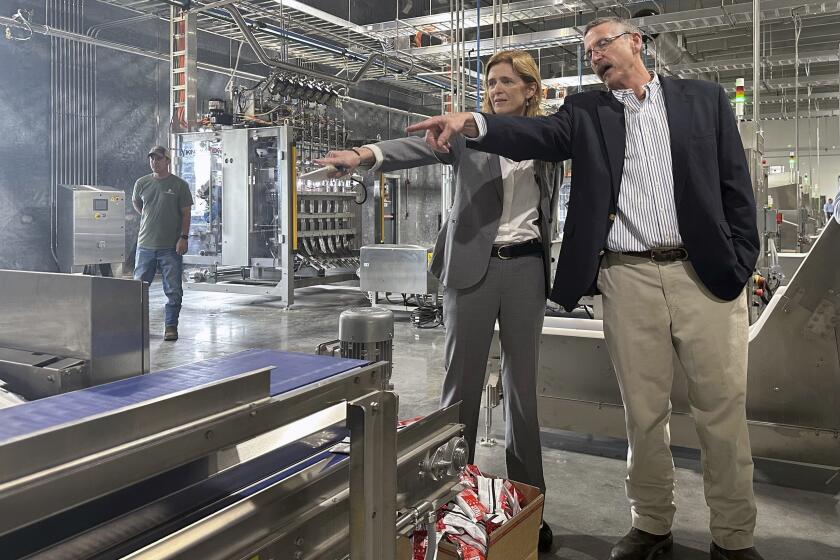DRAWN TO DANCE : PIANIST TO PLAY TANGLE OF TANGOS
From the back streets of Buenos Aires in the 1880s to its heyday as a chic 1920s ballroom dance, the tango has had an exotic and erotic career.
Before World War I, it was condemned by the Pope, and even the iconoclastic French composer Erik Satie called it the “devil’s dance.” Although the tango has recently enjoyed a modest revival on the both the stage and the dance floor, rarely has it been taken seriously by composers of note.
Pianist Yvar Mikhashoff, a specialist in contemporary and avant-garde keyboard music, has attempted to right this oversight by commissioning a host of contemporary composers, from Aaron Copland to John Cage, to write tangos.
“The idea to do the tango project came to me in May, 1983. I was always asking my composer friends to write pieces for me, and I liked the idea of collective composition,” Mikhashoff said.
He said the most celebrated example of collective composition is Austrian publisher Anton Diabelli’s commission to 50 composers to write a composition based on one of his waltz tunes. But without Beethoven’s stunning contribution, a set of 33 variations known as the “Diabelli Variations,” history might have forgotten the project.
Mikhashoff wrote to 110 composers. “I asked them to make it short, under three minutes, and soon I had 88 pieces, although tangos are still coming in,” he said. “I just received a new one from Paul Attinello in Los Angeles earlier this year. He came up to me after a concert I played and said, ‘Here’s your tango.’ ”
Wednesday night at UC San Diego’s Mandeville Auditorium, Mikhashoff will premiere Attinello’s tango on a program with 18 other tangos from his collection. He will augment his piano performance by showing a five-minute sequence of “Four Horsemen of the Apocalypse,” in which Rudolph Valentino does his celebrated steamy tango, and a clip from the 1935 Fred Astaire-Ginger Rogers film, “The Story of Vernon and Irene Castle.” According to Mikhashoff, the Castles, a popular pre-World War I dance team, helped make the tango respectable.
Mikhashoff, a music professor at State University of New York at Buffalo, said that he was naturally drawn to the tango because he was a championship ballroom dancer as a teen-ager and the tango was always his favorite dance. As a performer, he has a decided preference for playing the works of living composers, so the collective tango project fused these two interests.
“I am dedicated to living composers,” Mikhashoff said. “If I were living in ancient Rome, I would have altars to them in my home: they would be gods.”
To his composer colleagues, he offered no money to write the tangos--only two actually requested a fee--but he could guarantee that he would program the compositions wherever he performed.
“For the contemporary composer, performance is the ultimate reward,” he said. Last season in New York City, Mikhashoff played all of his tangos in a four-concert marathon that drew his most enthusiastic audiences, not to mention favorable words from a New York Times reviewer. He has played his piano tango marathons from Seoul to London to Toronto; his longest marathon was a non-stop eight hours of tangos in Stockholm.
Not every tango in Mikhashoff’s collection sounds like a peppy accompaniment to an Arthur Murray dance lesson. “John Cage’s piece sounds like an ‘erased tango’--like you are in a room and think you hear a tango in the next room. It’s really fragments of a tango, not more than 20 seconds in length. The challenge of the Cage tango is interpreting its bizarre notation. It’s just a single line of music, which needs to be realized in an imaginative way.”
Some composers explored the humorous possibilities of a tango commission. Robert Berkman’s tango, which Mikhashoff will play at UCSD, is entitled “Thorn-Torn Lips.”
“That’s what happens when you kiss a tango dancer holding a rose between her teeth,” he said. “Berkman is more of a ragtime piano player than a composer, but it’s a clever piece--a ragtime player trying but not succeeding to write a tango.”
English novelist Anthony Burgess, of “A Clockwork Orange” fame, sent Mikhashoff what he calls “a really stunning piece,” and the late Dane Rudhyar discovered an unpublished tango he had written in Paris in 1914 and sent it as his contribution. Other tangos on the Wednesday program are by composer-conductor Lukas Foss, William Bolcom, Ralph Shapey and Conlon Nancarrow.
More to Read
Start your day right
Sign up for Essential California for news, features and recommendations from the L.A. Times and beyond in your inbox six days a week.
You may occasionally receive promotional content from the Los Angeles Times.





